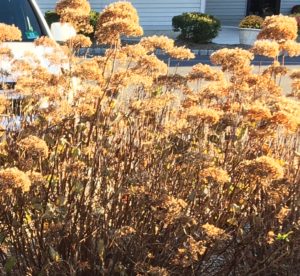Hello fellow readers, It’s the time of year for tending to leaves and tidying our gardens for a long winter’s rest. The truth is, though, our gardens don’t rest. The fallen leaves and decaying plant material provide nourishment for next year’s growth by decomposing and putting nutrients back in the soil. Hence, not doing a thorough garden cleanup makes a good deal of sense.
Dry seeds provide food for our feathered friends, and dormant foliage provides shelter for birds and beneficial insects, cocoons, caterpillars, and eggs. Besides that, dry seed heads and foliage can be beautiful in the garden. Savvy gardeners plan accordingly. Think of your winter garden as a dry floral arrangement with the added benefit of evergreens.
Most know how lovely ornamental grasses are left standing. Then there are the pompom-like black-eyed Susan seed heads (Rudbeckia hirta) that are especially cute frosted with snow. However, “rude Becky” can make too many babies. The same can be true of purple coneflower (Echinacea purpurea), so I leave only a few seed heads in key spots for winter interest. The new growth of Butterfly Bush (Buddleja davidii pictured above) looks like starbursts. They also have prolific seeds that disperse easily, so many categorize them invasive. I cut off the dry seeds, dispose of them in the takeaway trash, and prune back the plants for a tidier display over winter. Then come spring, they’re cut down to a foot high to rejuvenate each plant.
The handsome husks of the Siberian iris (Iris sibirica) have split tops that look liplike with black seeds that rattle in the wind. Late blooming ornamental onions (Allium) such as ‘Summer Beauty’ and ‘Millenium’ are magnificent dry. Then there are Sea hollies (Eryngium) with cone-like flowers that dehydrate intact. Many salvias, such as Salvia nemerosa and S. pratensis, provide winter texture long after their blooms fade away. St. John’s Wort (Hypericum calycinum) is a semi-evergreen groundcover with rosebud-like dry seedpods. Hydrangeas look fabulous over winter too. Panicle hydrangea (Hydrangea paniculate) bloom from mid-summer into fall, then turn golden wheat. My favored oakleaf hydrangea (Hydrangea quercifolia) has pealing rust-colored bark to compliment the dry flower heads.
With this fall’s extended warmth, some plants are not yet dormant. So, you neat and tidies, be careful not to cut back plants too early. And when you do, consider keeping some seeds and foliage intact for the critters and the nourishment of our dear earth.
Garden Dilemmas? AskMaryStone@gmail.com (and your favorite Podcast App.)






Great point about letting some of the foliage fall and rest on the ground. Nature has a fantastic way of recycling itself, and yet still being so beautiful.
I agree, Sally! Thanks for your comment and for reading my column :^), Mary